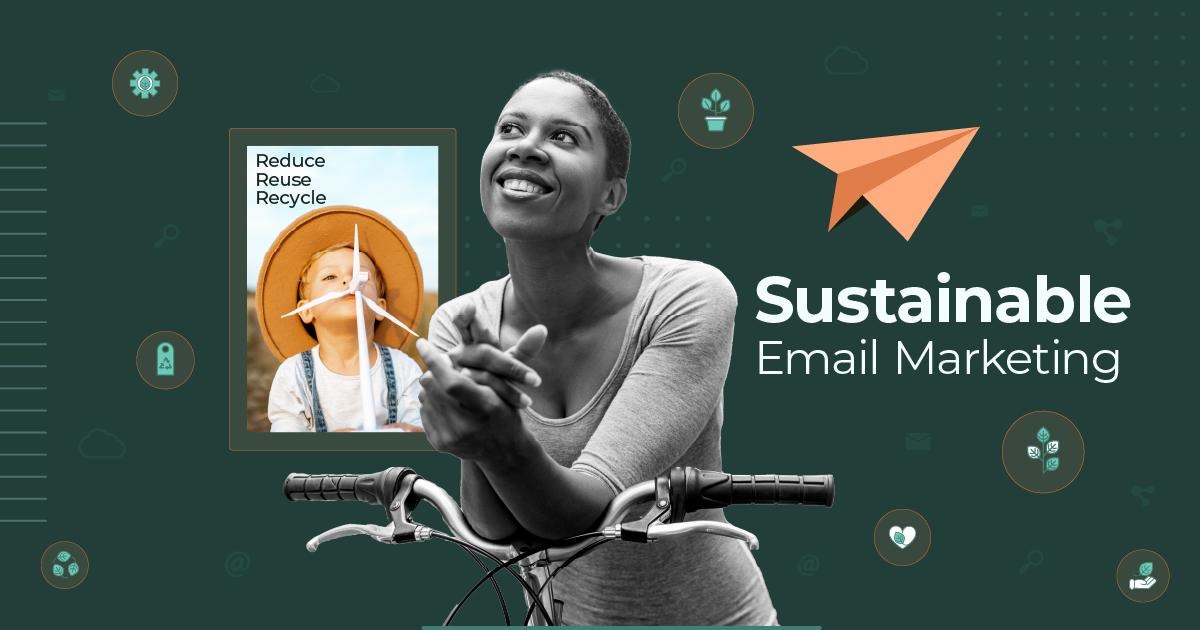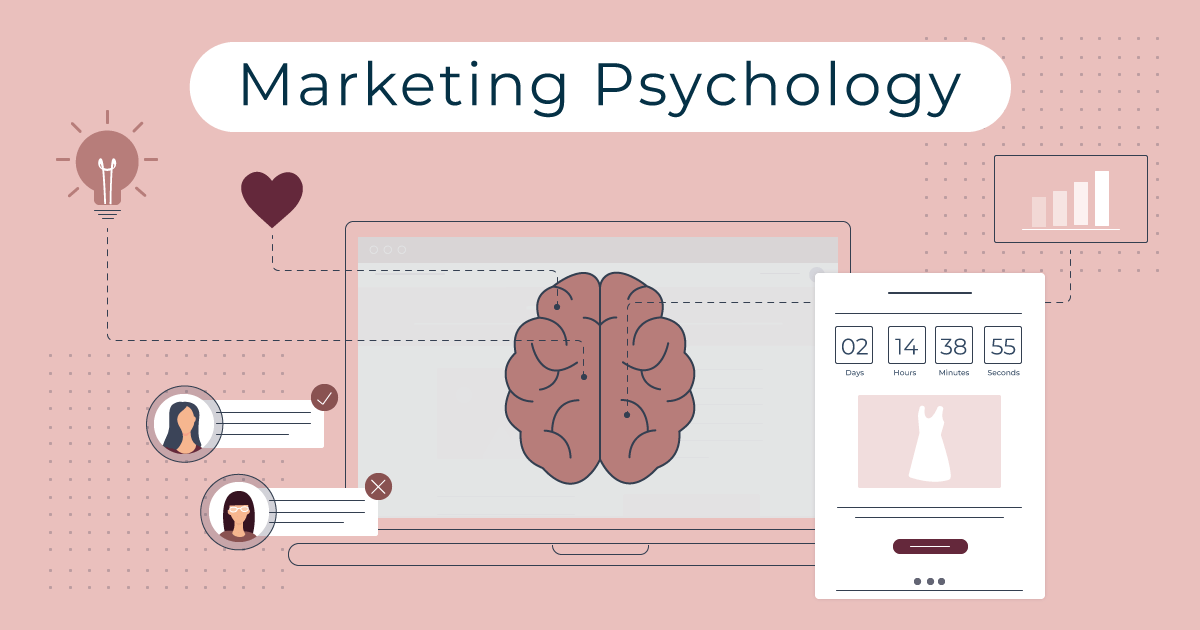
Empathetic Email Examples To Build Authentic Connections [2025]
Scarcity and urgency made their way into our email campaigns a long time ago. But there’s a new kid in town, and some of us haven’t said hello yet.
Far from a principle or trend, empathy is a way of thinking. And when used in email marketing, it paves the way for deeper and more authentic relationships.
But it’s okay not to know where to start. Or where things could take the wrong turn. Our favorite empathetic email examples will give you an idea of how to empathize with your readers while sounding genuine.
Plus, after reading all the do’s and don’ts in our guide, you’ll be ready to dive into empathetic email marketing.
Strong emails build stronger bonds
Craft meaningful campaigns with Moosend’s polished templates.
Start freeWhat is Empathy in Email Marketing? (and What Isn’t)
Empathy in email means putting yourself in your subscriber’s shoes. It also involves describing their feelings in a way that resonates.
Think of it this way: your roommate does the dishes because you’re working overtime. Or a total stranger walks past you to avoid scaring you off during your night walk. That’s what empathy feels like in real life.
Empathy in email can take various forms. For instance, it may look like a sincere apology for a delayed order or a message showing support during a difficult time (e.g., a natural disaster).
On the other hand, an empathetic email isn’t about promoting a product right after a disaster or disguising a series of sales pitches as an emotional story.
That crosses into performative marketing. This happens when brands try to sound caring but don’t back it up with real support or value. What sets it apart from an empathetic message is the lack of sincerity and action.
Why Do You Need Empathetic Emails?
Using empathy in email marketing doesn’t mean stepping into your subscribers’ lives or assuming how they feel. It means acknowledging that everybody is different and making the effort to respect and support those differences.
An empathetic email shows your subscribers you care and that their needs matter more than the sales. In other words, sending emails that work for them, not your KPIs.
Especially in times of crisis, brands that practice empathy stand out.
Marketers are also picking up on this tendency. This is why the majority report empathy in their messages as the most important factor in meeting customer expectations:
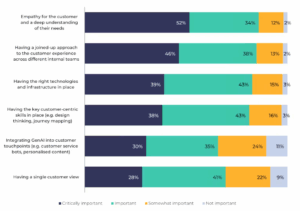
Now let’s see why that is.
Your messages stick with subscribers
Empathetic emails are written with subscribers’ emotions and concerns in mind. As a result, these branded messages resemble real-life, human-to-human connections.
A great empathetic email example makes individuals feel seen and valued, as in their personal relationships. Therefore, they tend to remember the brand that offered them that authentic, emotional experience.
You increase customer satisfaction and loyalty
The desired outcome of every interaction is to have a satisfied customer. But even if they aren’t, an empathetic message demonstrates you’re taking steps to serve them better.
These efforts increase trust and help ease any frustration, making it easier to retain customers and earn their long-term loyalty.
You showcase your values
Brands aren’t isolated from society. Besides industry trends, you should stay up to date with social, economic, and environmental issues. On top of that, businesses need to respond to global and national emergencies to show awareness and responsibility.
That’s because when choosing between two brands with equally great products, a concerned consumer will probably turn to the one that shares their values.
You reduce the impact of a bad experience
In the case of a difficult situation like a delayed delivery or a PR crisis, you need to make up for the trouble. An empathetic email with a transparent message prevents things from escalating and usually has a soothing effect.
Plus, it buys you time to find the best solution and communicate it to your audience, turning a negative experience into a positive one.
How to Write Empathetic Emails
When embracing empathy, it all comes down to considering how your customers are feeling. Here’s what else you need to know to write effective empathetic email campaigns.
1. Understand your audience
That inbox you’re trying to reach belongs to a real person. And no real person is the same as another. They laugh at different jokes, get moved by different songs, and relate to different stories.
Generic messages are the exact opposite of empathetic emails. So, before writing an email, dive into your readers’ core values, fundamental needs, and current challenges.
You won’t find that kind of insight in basic demographics.
For instance, you might know that the subscriber is a 35-year-old female living in a big city; however, this doesn’t tell you that she’s trying to combine remote work with parenting or that she’s environmentally conscious.
So, how do you find out?
- Use your CRM, analytics, and email metrics to identify the kind of content they engage most with.
- Perform social listening to monitor your audience’s interactions on social media. What are they talking about? Which posts do they like, share, or comment on?
- Ask them directly through surveys, polls, and quizzes. But don’t limit yourself to substantial questions like their preferred products; aim for their biggest pain points and the outcomes they’re hoping for.
- Set up an email preference center so they can pick their favorite content types and formats, name their challenges, or fill in their interests.
A reliable email platform like Moosend makes things easy by allowing you to set up an email preference center for your campaigns and get instant access to valuable insights.
2. Keep things simple
Effective empathetic emails mostly rely on the persuasive power of words. Think of simple and compassionate language that passes the message across.
In some cases, cluttered designs do more harm than good. And usually, empathetic emails go hand in hand with minimalist and clean layouts that make an impact through the copy and the story shared.
This doesn’t mean you won’t incorporate any visuals or colors. But they shouldn’t distract the reader from your core message.
So, avoid flashy graphics, trending GIFs, and interactive elements that don’t add to the message. Instead, choose subtle colors and meaningful visuals that complement the email copy without overwhelming the subscriber.
Let’s say you want to send a nonprofit email marketing campaign to raise awareness of a specific cause. You can pick a professionally designed email template and build on it based on requirements.
No need for sales-focused CTA or copy, impressive graphics, or puns and catchy phrases. Just a clean design, a clear CTA, and straightforward copy that makes your message pop while highlighting the impact of your recipient’s contribution.

Moosend offers a library of ready-to-use email templates for every occasion. So, you get responsive, clean, and fully customizable designs to use as a starting point for your empathetic email campaign.
Just pick the one that better serves your campaign objective. Then, go to the drag-and-drop editor and start tweaking the layout to perfection, adding your logo, changing colors and fonts, and adjusting any element as you please.
3. Use appropriate language
Sometimes, empathetic email campaigns require a different tone, especially if there’s a difficult situation involved. When writing your emails, ensure you:
- Use a friendly and compassionate tone, steering away from jargon and buzzwords.
- Strike the right balance between cheerful and optimistic; the last thing you want is to make your subscribers sadder than they might already be.
- Double-check that no element in your email could come across as insulting or insensitive to any group.
- Get to the point and take responsibility (if you have to).
- Avoid “passive-aggressive” wording when you need to apologize for an incident.
- Opt for relatable, not sympathetic. Your audience needs to know you understand, not that you feel sorry for them.
In general, the key is to listen to how your prospects and customers talk about their pain points and try to speak in their language.
Also, it’s not like you can never use humor in empathetic emails. For instance, in use cases like anniversary or birthday emails, a healthy dose of humor couldn’t hurt, given that the message will probably be more lighthearted.
4. Tone down the sale messages
Not every email is a hard sale opportunity. And this is even more true when there’s an unexpected occurrence involved. We don’t say you should stop selling during hard times. However, it’s better to prioritize valuable content with a sense of empathy.
Also, make sure to include any relevant information. For example, if your empathetic email has to do with price increases, clearly mention when the change will take effect and outline the new pricing details.
Similarly, if you’re having trouble with your supply chain, use an out-of-stock email to let your customers know when the product will become available again.
In any case, focus on the next steps your business is taking to address an issue, help with a humanitarian crisis, or just offer a better customer experience. The goal is to make your subscribers feel seen and cared for.
And if you have to promote some of your products or services during hard times, make sure you do it in a timely and ethical way.
5. Be transparent
Empathy in email marketing starts with transparency. Being upfront about your intention and practices shows your audience that you mean what you say. Also, it signals that empathy isn’t just a tactic for you but an effort to connect.
When your words match your actions, you prioritize long-term trust over short-term attention.
On the flip side, if you promise to adopt certain practices but don’t, it could seriously damage your reputation.
Here are some important things you have to be transparent about:
- Your mission and values
- Important business updates
- Data management and privacy
- Measures to address potential issues like service disruptions
- Other expectations, e.g., the frequency in which you’ll contact them
Let’s take sustainable practices as an example since they have become a main concern for consumers. According to Deloitte’s findings, 68% of consumers reduce food waste, and 61% limit the use of single-use plastics. They expect the brands they trust to not only adopt the same practices but also put them into action.
To show them where you stand, share the initiatives you’re taking towards that direction instead of just talking about sustainability.
With this rising awareness about single-use plastics in mind, Fussy created a welcome email to share the idea behind the product. In it, they don’t go on and on about it, but translate the potential impact that sustainable products have into measurable outcomes.
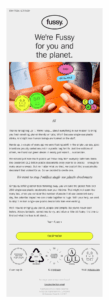
6. Adapt your strategy when needed
Setting up any marketing strategy takes serious effort and teamwork. So, shifting from it might sound like a lot to take on. Nonetheless, a successful strategy has to be flexible. And when your brand needs to pivot, everyone on your team should be ready to follow.
Understanding your customers’ perspective is essential during uncertain times. Tweaking your messages to fit their current needs signals a thoughtful and adaptable brand.
Treat any change with respect, acknowledging the challenges that your audience is going through. That promotional campaign you have scheduled? If it doesn’t fit the current climate, consider leaving it for a more suitable time.
Not any scenario requires drastic measures, though. You might just need to revisit your automated sequences and tweak the content accordingly. Remove inappropriate language and any component that feels out of touch to align with how your customers feel now.
This empathetic email example by Harry’s was sent during the pandemic. They treated the occurrence as an opportunity to give back to their subscribers. Plus, they partnered with another company to help with anxiety, which was a common pain point at the time.
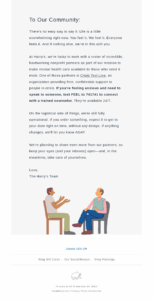
Great Empathetic Email Examples to Use
Now it’s time to check seven great campaign examples and why they stand out:
1. Delta’s apology email
Subject line: From the Delta Team: Thank You for Your Loyalty

What do we do when an unfortunate incident occurs? Unfortunately, human nature tells us to ignore it and keep going as if it never happened.
But that’s not what your customers want when a disruption happens. This is why Delta chose otherwise and sent the above empathetic email example to apologize and say thank you to travelers for their loyalty.
Why we liked it:
- The lack of unnecessary design elements lets the key message pop.
- The email is signed by two C-level executives, which gives a personal touch to the message.
- The brand uses the email copy to acknowledge the subscribers’ anxiety and commit to doing better.
- They deposit 10K miles to the recipient’s account to rectify.
2. Yellowbird’s opt-out campaign
Subject line: Hoping to opt-out of Mother’s Day messages?

Many brands showcase their sensitivity by being respectful in the emails they send or don’t send to their readers. A subtle opt-out goes a long way, using email personalization to help subscribers get through specific days.
Yellowbird’s opt-out campaign gives subscribers control over the content they receive. The brand offers them an option to unsubscribe from Mother’s Day messages, which may be potentially triggering, but without opting out entirely.
Why we liked it:
- They communicate the idea behind this opt-out email, which is an effort to identify with their audience’s pain points.
- The call-to-action is clear and visible so subscribers can easily update their email preferences.
- They reassure the recipient that they’ll still get valuable email content in their inbox, but just the fun and helpful type.
3. 4Knines’ return policy update email
Subject line: 🥳 We’ve Got Big News!

Empathy is mostly about addressing your audience’s pain points. Offering solutions shows empathy in a practical way, and customers reward the brands that take action with their loyalty.
4Knines’ empathetic email example informs subscribers about their new 60-day return policy. A smart move that takes some of the pressure off from deciding whether the purchased product is a good fit.
Why we liked it:
- The catchy heading immediately tells the recipient what they gain.
- They add a brightly colored and actionable email CTA that communicates the change.
- The ample white space and well-structured list let the reader focus on the key benefits of the new return policy.
4. Earthfoam’s informative email
Subject line: Keeping our Prices Low… Every Day

Remember how we talked about empathy and transparency going hand in hand? This involves keeping customers in the loop and providing critical insights into the way you do business.
Earthfoam’s campaign is a great example of an empathetic email using the bare minimum elements to fulfill its purpose: keeping customers informed about the brand’s supply chain, material origins, and pricing policy.
Why we liked it:
- They use a strong subject line to share their unique approach to pricing without relying on sales periods.
- They include resources for further reading to educate subscribers on their mission.
- The product image is placed above the fold so the reader can easily associate it with comfort and relaxation.
5. Red Clay Hot Sauce’s fundraising campaign
Subject line: Join us in supporting relief efforts for Hurricane Dorian.

In times of crisis, consumers expect their favorite brands to support the community. Consider donating a portion of your profits to support those affected by natural disasters, accidents, or other incidents, demonstrating your company’s care.
Red Clay Hot Sauce used the above email campaign to describe the problem caused by Hurricane Dorian. In it, they also list the measures they’re taking to soothe people’s pain.
Why we liked it:
- The subject line effectively describes the email objective while encouraging readers to act.
- They not only explain how subscribers can support the cause but also reassure them that the company’s founders will match the amount raised.
- The email ends with the founders’ signatures and a clever CTA in first person.
6. Who Gives a Crap’s promotional email (with a twist)
Subject line: Our copywriter had a baby

Who said empathy is only destined for customers? Why not start with your colleagues and employees? Letting subscribers know that you value your people and celebrate their milestones shows that you’re respectful to everyone you connect with.
Basically, they know that if you empathize with your team, you’ll do the same with them. Check out how Who Gives a Crap did it in this empathetic email example.
Why we like it:
- The email copy is original, and so is the idea behind the email, which is why this empathetic campaign example doesn’t resemble any promotional message we’ve seen.
- The reference to the copywriter and her baby adds a personal touch, making the reader feel part of the team.
- They don’t lose the opportunity for a sale, but they don’t force it either, with the calls-to-action being naturally incorporated in the content.
7. Better Brand’s informative email
Subject line: 3 Tips to embrace self-care

Sometimes empathy simply means delivering educational or informative content to help subscribers improve their daily lives. That doesn’t mean you can’t showcase your products or services. If you focus on how they solve your subscribers’ pain points, your message will still come across as helpful and relevant.
Better Brand shared tips on how to prioritize self-care.
Why we liked it:
- The subject line teases the email content while the peaceful image at the top gets subscribers into the right mood.
- They add value with actionable tips that showcase the brand’s expertise.
- They present their products as the solution and prompt readers to shop for them through two prominent CTAs.
Let Empathetic Emails Guide Your Strategy
Empathetic emails lie at the core of a customer-centric approach where you tune in with each subscriber’s needs. In simple terms, you put your audience first.
The key is to focus on building connections rather than pursuing sales and promotions. If they have your support and understanding, then those will translate into purchases down the line.
So, before writing your next email, consider how your readers feel, think, and talk about their problems. Then, make sure your email content reflects your understanding of their needs.
What you’ll get in return is deeper and trusting relationships with your audience that will think of you as an authentic and reliable brand.
Want to connect with your subscribers in a meaningful way? Sign up for a Moosend account today and use features like list management, dynamic content, and automation to understand and target readers with the right empathetic email.



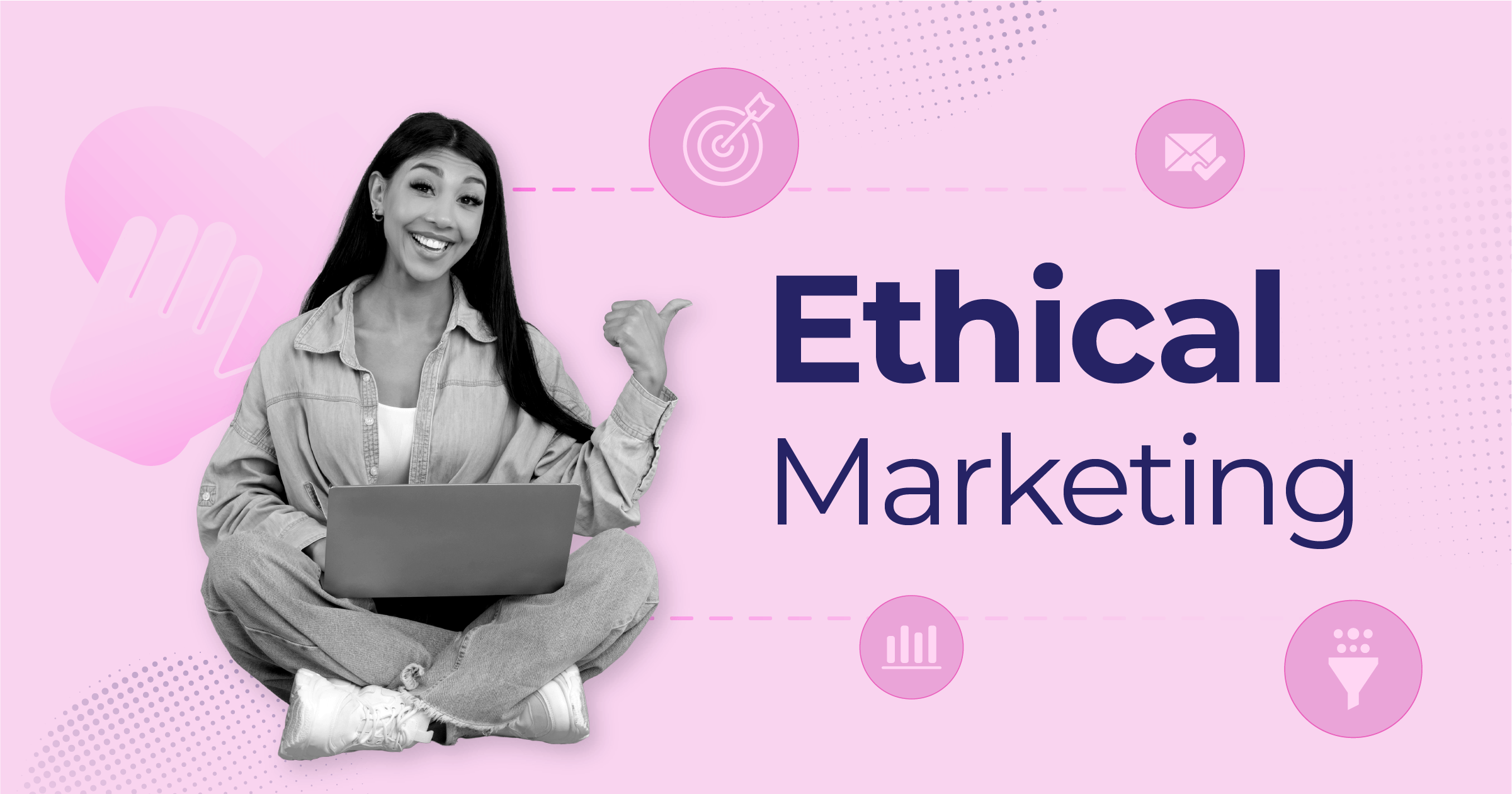
 Published by
Published by
